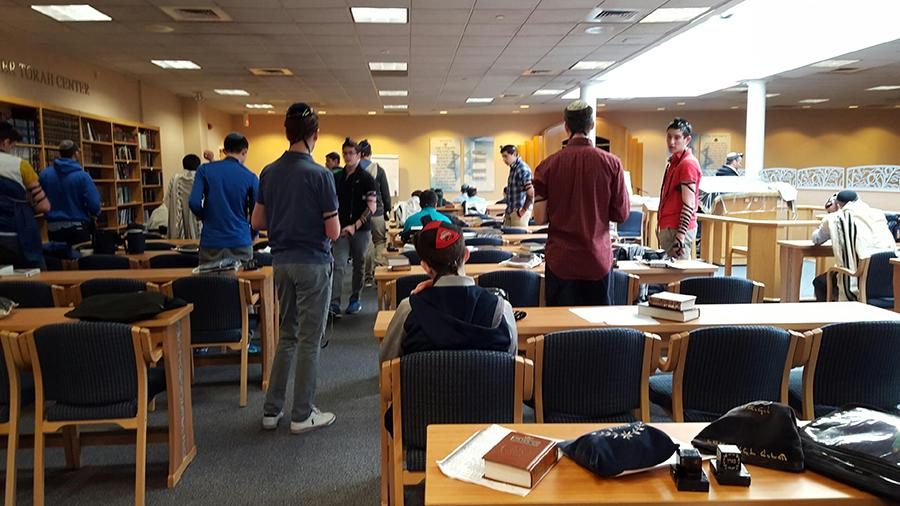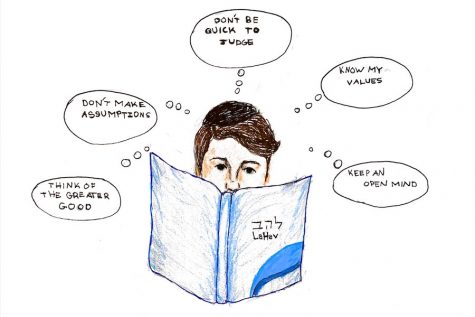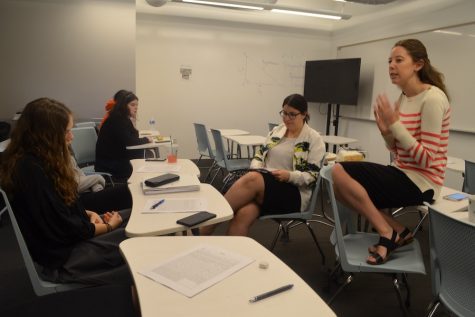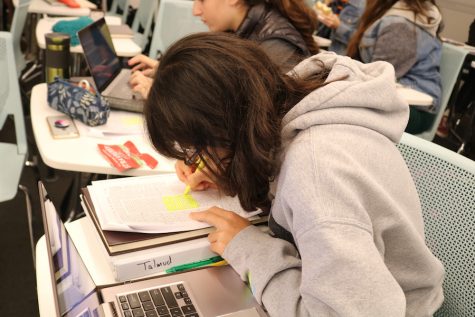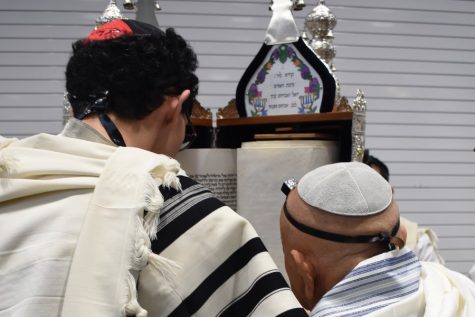Across nation, various ways to spiritualize davening
Photo Courtesy of Gabe Zuckerman, Kushner
SIMILIARITIES: Students at the Rae Kuskner Yeshiva High School in New Jersey all pray together in one minyan.
It might have been unusual to open a student-led discussion about davening options at Shalhevet’s Just Community meetings last fall, but the wide range of choices that came out of it is not unusual at all in Modern Orthodox high schools.
A Boiling Point survey of seven schools from L.A. to Chicago and New York found a range of minyanim available to students throughout the country. The reasoning everywhere is pretty much the same.
“One goal for davening [prayer] is finding connections, and not everybody needs to be doing the same thing or is going to connect in the same way,” said Lisa Schlaff, Director of Judaic Studies at Salanter Akiva Riverdale (SAR) High School in Riverdale, N.Y.
“There are some people who meditation is going to be a wonderful way for them to daven…and there are going to be other students who are not going to connect in that way at all, and we don’t want to say everyone has to do the exact same thing.”
While alternative minyanim vary from school to school, most take similar approaches to attendance and minimum requirements, and no one insists that students actually pray. Nonetheless, each school has unique features.
Hashkama minyan and the recently implemented reading policy are unique to Shalhevet.
Unusual choices elsewhere range from a meditation minyan to a solitary minyan, where students worship a set distance from one another. Some schools provide the options every day, while others only offer them during certain times of the year.

A sephardic minyan at SAR High School in New York, one of the more common options in schools surveyed.
Ramaz High School in New York City and Ida Crown Jewish Academy in Chicago and Shalhevet have girls’ singing minyans. Rae Kushner Yeshiva High School in New Jersey offers grade-wide girls’ tefilla groups.
Almost every school has a standard Ashkenazic minyan and some different choices. Other typical options are girls’ minyans, Sephardic minyans and explanatory minyans.
YULA Boys, Ramaz and SAR also host Sephardic services. SAR senior Eli Best attends one even though he is not Sephardic.
“It’s a whole different culture and it’s a really interesting way, contrary to what I normally do,” Eli told the Boiling Point.
Ida Crown and Ramaz both allow students to attend explanatory minyans, where students learn about davening, though they don’t meet everyday. The students say the main parts of the service, but do not say everything – so there is time to learn. YULA Boys school tried an explanatory minyan last year and will be bringing it back this year second semester, according to YULA Principal Rabbi Arye Sufrin.
“You get 25 to 30 kids not coming for food or the honors credit but to gain something,” Rabbi Sufrin said. “They really feel that they are learning something every time.”
Both SAR and Ramaz offer music minyans as well. In past years Shalhevet has had a music minyan, but not this year.
Noah Greenwald of New York attends the singing minyan at Ramaz.
“Its a really good time,” said Noah. “Everyone is really into it, everyone chooses to be there and its different then your usual sit down davening.”
SAR has three unique minyans called the meditation minyan, “neo-chasidut minyan, and miat bikavana minyan, translating to short, but with intention.
The neo-chasidut minyan holds parts of davening outside, while the miat mikavana minyan says fewer parts of davening, but takes longer to say each part.
Ida Crown is the only school with a solitary minyan, in which students sit about 10 feet away from each other and daven by themselves. Ida Crown junior Yardayna Ben Simon enjoys it.
“I’m at solitary and for me that’s the best way to daven,” said Yardayna in an interview. “You daven to yourself and you don’t have to go at a certain pace so it just works best for me.”
Only Kushner and YULA girls have everyone daven together every day.
Kushner junior Gabe Zuckerman does not mind only having one minyan and he enjoys davening there.
“I kind of like the standard minyan,” said Gabe. “It’s traditional, it’s nice.”
AT YULA Girls, students say up until Baruch She’amar together, but then say the rest individually because there is no male chazzan to lead.
“I like that it is independent,” said junior Jenna Kirschenbaum. “When it comes to davening by yourself, you can choose which parts you find most important in the davening.”
Shalhevet’s most successful voluntary minyan is its daily Hashkama, or sunrise, minyan, and this year it also has the girls singing minyan, a freshman-sophomore grade minyan and a junior-senior minyan. Occasionally a meditation minyan is also offered, led by Judaic Studies teacher Ms. Ruthie Skaist. By far the most popular minyan is Hashkama, which starts at 7:25 a.m., 35 minutes before school. Students run the minyan without faculty and finish davening right before the start of first period. Then they have a free period while the rest of the school attends Shacharit from 9 until about 9:30 a.m.
Minyan founder and current senior Noah Rothman said that Head of School Rabbi Ari Segal suggested that he start the minyan when he was a sophomore. Noah did not realize that it would become the most popular minyan in the school.
“We started getting 15 people and then 30 people, and then 40 people and it really took off,” said Noah. “It’s a good davening experience. For the most part it is silent, we say a lot and we move quickly.”
Junior Nicole Miles attends the minyan everyday.
“I feel that the people around me are glued to their davening more than in regular minyan,” said Shalhevet junior Nicole Miles. “I feel like I can daven better there.”
Also completely unique to Shalhevet davening is something that came out of the Just Community meetings: that students can read from a list of approved Judaic books instead of davening when at the Main Minyan.
It was first suggested by Just Community reorientation at the beginning of this school year. Senior Boaz Willis sometimes takes advantage of it.
“If you’re reading something that is making you think about God or Judaism or your place in the universe, then that is a form of tefilla [prayer],” said Boaz. “You are davening, just doing it in another way.”
Principal Reb Noam Weissman explained why he agreed to allow it.
“I want them to be learning, I want them to be doing something meaningful,” Reb Weissman said in an interview. “We’re never going to force a kid to say a word of davening, so we do expect a culture of respect.”
While no other school allows this as an official option, most schools would allow certain students to read if the rabbis felt it appropriate for that particular student, they said in interviews.
Schools have varying standards with regard to what a student must do or say during tefilla. But most schools, including Ramaz and SAR, the requirement is an open siddur, which follows what the rest of the minyan is doing.
“Students need to be part of the kahal,” or congregation, said Mrs. Schlaff. “In order to create a community of people who are davening, you need to have a siddur, the siddur needs to be open to the right page, and if everybody is sitting you need to sit.”
Requirements depend on the specific minyan at Ida Crown.
“The kollel minyan, they have to be davening. If you’re not davening, you’re out of that one,” said Ida Crown Rabbi Joel Gutstein. “The other two we don’t force them to daven, the learning one and solitary.”
Faculty from Shalhevet, SAR, Ramaz and Ida Crown all agreed that students cannot be forced to pray.
“I can’t force you to daven, because that’s between you and God,” said SAR’s Mrs. Schlaff. “But you do need to understand that you need to be a presence in this room who is contributing to the atmosphere and not taking away from it.”
That policy is universally appreciated.
“I don’t feel like I’m always getting commanded to daven,” said Gabe of Kushner. “I feel like it allows me to do it on my own at the same time as being in a facilitated, traditional way.”
But in spite of all the energy it takes to make prayer work for the greatest number of students, no school officials would consider giving it up. Prayer seems to be something that every Modern Orthodox school is determined to teach.
“Why do we daven?” said Reb Weissman. “There are multiple ways to have that connection to God — through tefilla, through talmud Torah, and through g’milut chasadim,” or acts of kindness.
“And tefilla is a very important avenue.”

Since freshman year, Alec Fields has written numerous stories for the Community, Torah, Features, Outside News, Sports and Arts and Culture sections. In 10th grade, Alec received the post of Torah editor and held that position until being named co-Editor-in-Chief for the 2016-2017 school year. He has received awards for, "SUMMER OF WAR: Hollywood, too, was divided," “Refusing Playoff Suspension, Buckley Resigns,” “OUT OF THE SHADOWS: Ancient tradition meets modern sensibility,” and for “Rabbi who sauna-ed with students in New York was scholar-in-residence at Beth Jacob on Shavuot.” Alec is co-captain of Model Congress, co-president of the Finance Club, a founder of Supplies on Demand, a member of the Mock Trial team, Firehawks for Israel, tennis team and grappling club. Some of his favorite classes are Political Theory of Modern Middle East, Psychology, and Government and Economics. When Alec has time he enjoys playing or watching sports, reading...

